Vibha Galhotra
The earth’s composition is seventy percent water. Our body’s composition is an average of sixty percent water. In this relationship, the environmental responsibility of human beings towards the vitality of preserving the major percentage of an element that supports the entire eco-system is practically none. ‘Sediments and Other Untitled…’ is an ongoing project, which is a result of two years – 2011 to 2013 – of the artist’s experiences and observations along the Yamuna River in Delhi, and the Mithi River in Mumbai; in relation to the continuous destruction of the environment. Galhotra’s practice has addressed issues of borders and orders of the universe. This flow continues into her current series that addresses issues related to the co-relativity of water bodies, living beings and the outcome on the existence of living.
The artist captures the expressions of depression, playfulness and curiosity of the viewer with her use of unusual materials and mediums such as sediments, edible materials, fish, nets and glass beads. By collecting these polluted sediments and employing them as Indian ink, charcoal and color, Galhotra aims to mirror the silent darkness of destruction.
This is a phenomenon occurring in various countries – where the river is the only source that carries elements and forms welcomingly beyond political boundaries, people, homes and dwellings without questioning. In this ongoing series of ‘Sediments and Other Untitled…’ the artist continues to gather sediments and elements of rivers from all around the world to collate into an Orbis Unum (one world).
Text by Veeranganakumari Solanki
Sediment and other Untitled…, 2010-12, Vibha Galhotra. All images courtesy the artist and Rahul Aggarwal.
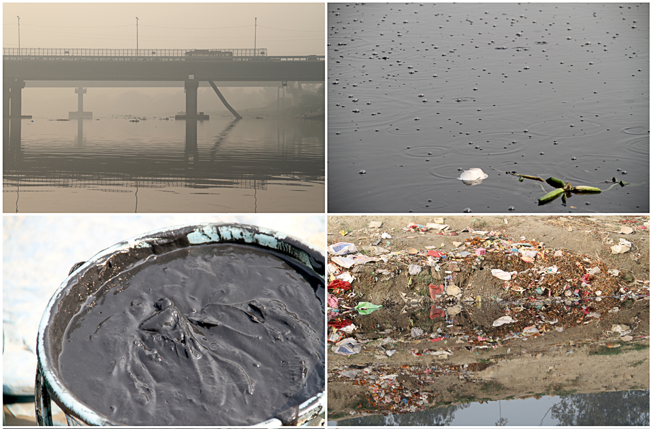
Documentation of the river and performance.
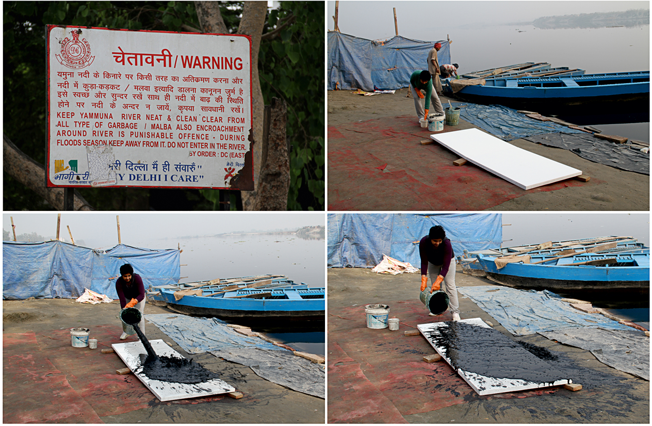
Documentation of the river and performance.
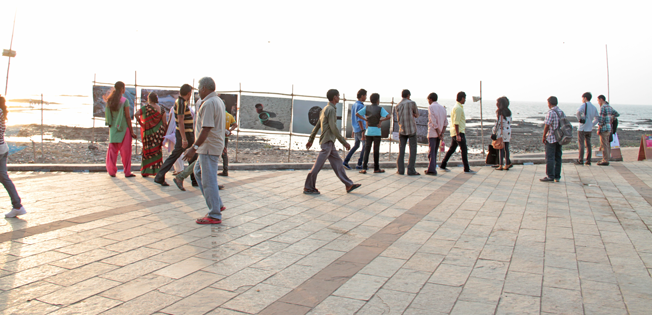
Installation view, Banks of the Yamuna River.
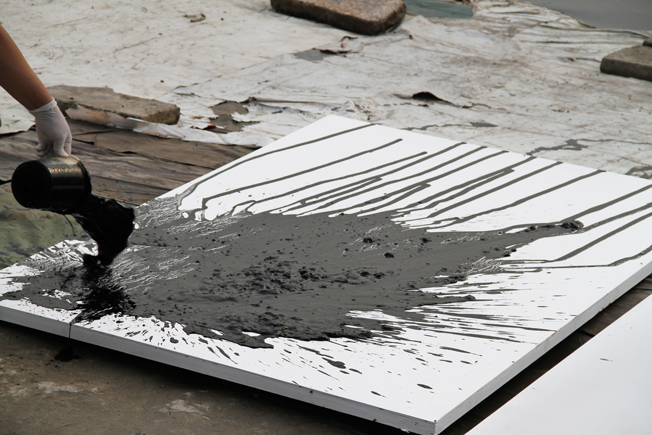
Documentation of the performance.
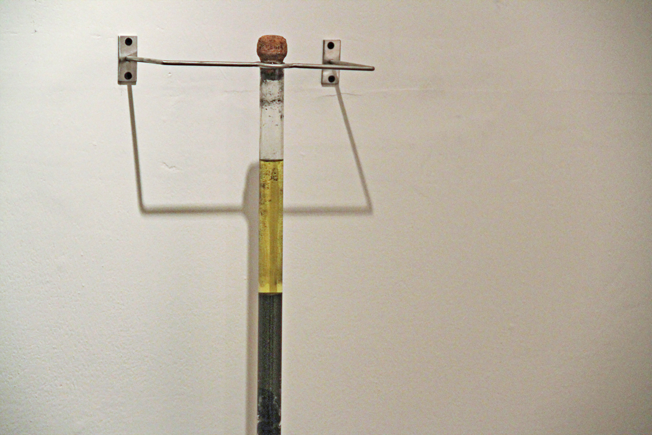
Sediment from the River Yamuna in Test Tube.

Untitled, found branch and concrete.
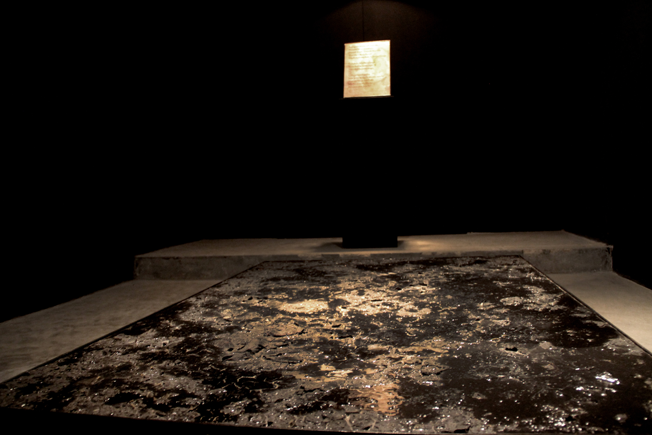
Installation view, Exhibit 320, New Delhi, India.
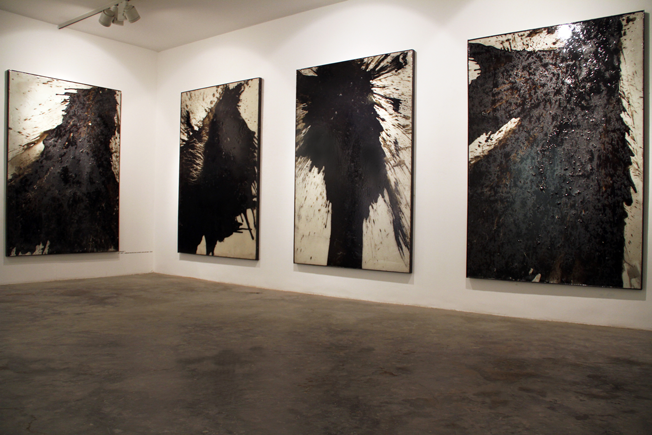
Installation view, Exhibit 320, New Delhi, India.
A conversation with the artist and Avantika Bawa
Avantika Bawa: Can you tell me about the Sediments and Other Untitled project?
Vibha Galhotra: My work addresses the transcultural on a global scale and specifically focuses on issues of displacement, nostalgia, identity, existence, construction or deconstruction, the banal, and cultural conditions born from the compromised environment in a constantly changing urban atmosphere.
The continual deconstruction of the environment inspired ‘Sediments and Other Untitled…‘ where, ultimately, my concerns are about myself and other living beings. I feel the whole world is going to face an environmental shift without an understanding of its borders and orders. Here, my focus pertains to the basic element of our body formation – WATER. This element, which was also the driving force of our planet’s formation, is not granted its importance in many parts of the world, especially in urban dwellings.
AB: What prompted your interest in this project?
VG: I occasionally go for walks around the Yamuna, one of India’s holiest rivers. Many cities, including the capital of Delhi, have developed around this river. It is the largest tributary of the River Ganga and considered extremely sacred. On a recent walk, I met Sanjay, a boat driver and dweller on the banks of the Yamuna, who has taken me on several boat rides. On each visit, the smell of the river has become more and more like the stench of sewage, thus making me breathless. As soon as the river enters in Delhi, most of the industrial waste converts the river into sewage and the water becomes a kind of a poisonous ‘black ink’.
This water directly affects all the people living in the cities around the river. The arsenic existing in it ultimately reaches our internal organs through the locally-grown food that we consume. To date, we, as a people, have only responded with excuses born of our own ignorance. I feel we all have to pay the toll of this destruction; therefore, in order to draw attention to this situation, I started this project.
AB: Regarding the current issue of Drain on Molecular: By unveiling, in the most artistic and profound way, the impurities and biochemical components of the sediment in these holy rivers, you draw attention to larger macro issues around the environment. Can you talk about this further?
VG: Through this work, I longed to capture the moment of depression in a very playful, satirical and curious manner. I applied the sediments that I collected from the river in the same way as I would use Indian ink and charcoal. The deep tones of this filthy visceral mud, splashed on white pristine canvas mirrors a situation of environmental darkness. Congruent to the environmental violation is the symbolic transgression of writing splashed/layered upon a blank sheet of paper. Mud traces, pollution, and ghastly slime act as signatures of the industrial. They are mud patterns/traces of structuralism as residues, in pursuit of the objective. In the one hand, there is the transcription of the black signage of paper, and on the other, the real violation of the Yamuna. But the actual violence does not lie in our seeing and grasping the direct, obvious, visibility of river slime. It lies elsewhere, in the under layers of our body, as fruits and vegetables; we purchase, cook and digest produce that is infected by immense pollution. The dark slime is inside our guts, as the mutation of unimaginable viruses spawn within; there is internal evidence of our own crime.
I strongly feel, as a viewer of the twenty-first century, that it is a circle of life, which one has to experience and observe and react to accordingly. This is not the time to play the ‘blame game,’ but to join hands in this moment to make the environment livable once again.
AB: This projects takes on many forms: performances, in the public domain; paintings and sculpture in a gallery setting; photography on the web and other media sources. With each iteration, the audience also changes. Are you partial to any one aspect? Do you think one is more powerful than the other?
VG: Quite a good question; let me try answer it, as I feel all audiences are good as long as they connect to the work and feel a sense of belonging. This project grew organically. Experiencing the sadness and denial towards it at the performative space (the banks of Yamuna in Delhi) was amazing and very inspirational. The dwellers spoke about their health problems because of the river water but refused to leave the contaminated space since they do not have anywhere else to go. They say this is their home and the source of life for them. They felt that my project was a source of hope for them. We formed a special bond and connection while creating this series of my work. The production of the project was a collaborative effort; the existing works in the gallery space created a sense of belonging.
It is a space where I had created or continued the dialogue from the performative space.
It feels like a journey of a painting from a sketchbook.
AB: What is the next project you are working on?
VG: There are two projects I am working on simultaneously. One is the continuing work with Sediment and Other Untitled… which involves lot of research, travel and documentation. I will travel from the place the river originates until the point it meets with two other rivers where it finally enters the Bay of Bengal. This project will involve narratives of personal encounters and meetings, as well as stories, readings, myths, observations, and history of the river. The other project is on its nascent stage, so as a personal choice, I would rather not speak about it at the moment…
In addition, at the beginning of 2015, I will be having a solo exhibition in the USA and India, so I will go with the flow.
Vibha Galhotra utilizes both abstract forms and images of the urban metropolis to address the radically shifting topography of India under the impact of globalization and growth. She sees herself as being part of the restructuring of culture, society and geography – of New Delhi, and the world. Her work crosses the dimensions of art, ecology, economy, science, spirituality and activism. Galhotra works in varied mediums including photography, animation, found object, performance, installation and sculpture. Noteworthy solo shows include exhibits at the South Eastern Centre Contemporary Art, USA; Ater, MK Search Art Gallery, San Giovanni Valdarno, Italy. Vibha’s work is in the collection of The Gates Foundation and San Jose Museum, USA, Essl Museum, Austria and the Singapore Art Museum. Most recently her work was included in ICASTICA, 2013 International Women’s Art Biennale, Arezzo, Italy, 2013. Vibhas work is represented by Jack Shainman Gallery in New York. A complete body of her work can be viewed at www.vibhagalhotra.co.in